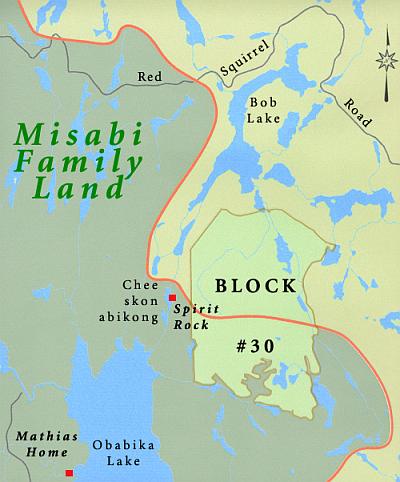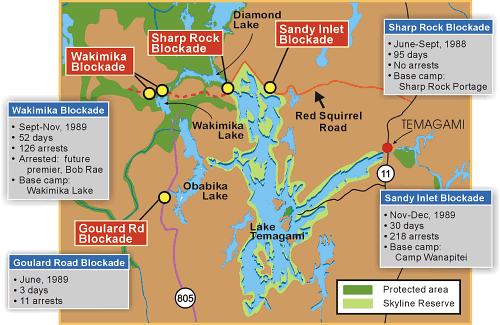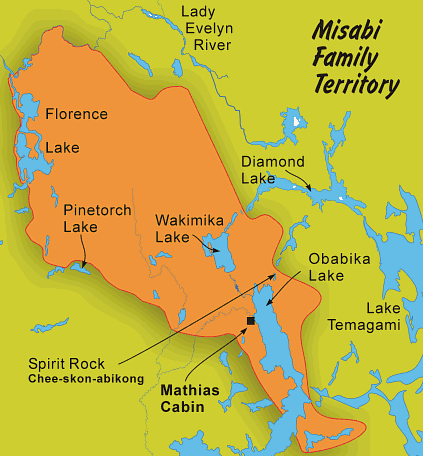|
Monday March 4, 2002
Dear CBC Radio and Television,
There are many points of interest in the Temagami area (a region in north-eastern Ontario), that I believe would be worthy for your coverage: nature in the area (the characteristics and uses of plant and animal life as understood by the local Native elders), Indian culture (this includes lifestyle , e.g. hunting and trapping, history (pictographs, artifacts and past events), non-christianized spiritual beliefs, the local Ojibway language, bush medicines, sacred sites such as the Conjuring Rock at Chees-kan-ab-kung Lake in the famous Wakimika Triangle, and bush crafts such as hand made sleds, baskets, cedar drums and masks), visitors recreational use (including camping, canoeing, hiking and snowshoeing), political issues such as how no treaty for the Temagami area has ever been signed and the ongoing negotiations between the (presently Chiefless) Band and province to settle a 110 year old land claim, as well as the recurring issues of mining and logging in the area.
Many protests have surfaced in the face of the destructive threats which logging andmining pose. The 1989 blocking of the Red Squirrel road extension where over 200 people were arrested. The highway 805 roadblock back in 1994, the 1996 protest of old-growth logging in Owain Lake and most probably the coming of the 2002 Block 30 protest and blockade ( please refer to enclosed BLOCKADES MAP).
Preservation of land and culture has been the struggle for all Native people world-wide for quite some time now. The present day traditionalist Native Indians of the Temagami area are no different in this respect.
Alex Mathias, a traditionalist Ojibway elder of the Temagami area, lives on his traditional family hunting ground, off-reserve, year-round with his wife and two daughters. His remote camp, which he built with the help of his wife, is located on Obabika Lake at the outflowing Obabika River ( please refer to MISA-BI FAMILY TERRITORY MAP).
As a young boy, Alex spent the winters with his adoptive parents and siblings living on Obabika Lake where they supported themselves by trapping fur-bearing animals (such as beaver, mink and pine marten) and also by hunting wild game such as moose, deer and partridge. Summers were spen guiding tourists mainly on Lake Temagami and some smaller surrounding lakes. This is the life-style most Indian families ( e.g. Misa-bi, Paul, Peshabo and Katt families ) kept during those times. Each family had their own hunting territory , within the Temagami area, where they would hunt and trap; where they would live.
These days, in the Temagami area, only Alex and his family live off-reserve, year-round, on their hunting ground. In order for them to have built their home and live there, they had to overcome many obstacles. For instance, in 1994 the Ministry of Natural Resources (MNR) blew two holes in their road: the Goulard Lumber Road. One of their reasons for doing this was to preserve the wildlife in that area, even though the road was initially installed as a means for lumber companies to access the timber and nothing but clear-cuts are visible along it.
Alex fixed the damage and continued to use the road. Built in the 1980's, the Goulard Lumber Road is a controversial, unmaintained, abandoned logging road. In 1995, the MNR also threatened Alex to stop his building , because it was taking place on what the MNR call Crown land and park land and that their cabin would be torn down (this letter is available upon request). Alex ignored the MNR and to this day continues to live there. I believe the MNR knows that Alex has a legitimate claim to the land, and hopes that by threatening him, he would be scared and leave. He does not leave, and every few years the MNR tells Alex that hisroad will be destroyed for one reason or another. Im 1997 the MNR offered $30,000 to the Goulard Lumber company to destroy Alex's road. Goulard refused saying a family lives at the end of that road.
Two kilometeres north of Alex's camp, yet still on his territory, is the internationally reknowned Wakimika Triangle. Here we find the largest stand of old-growth red and white pine in North America (if not the world). During the summer months , many recreational canoers from around the globe come to the Triangle to explore the trails and even to visit Alex to learn about the area and hear gis stories of his present and earlier life in the bush. The MNR has recently given permission for Liskeard Lumber to clear-cut log an area adjacent to the Triangle. Plans to log there are for some time this year: 2002. This area is being referred to as Block 30 (see enclosed BLOCK 30 MAP ).
I don't believe that the MNR want Alex and his family to live where they are because the MNR's plans for development , logging and mining in particular, are jeopardized. Alex is living the Indian culture he was brought up with and believes in preservatiob of his land and culture for future generations.
There are no powerlines, phonelines or running water to be found at his camp. Their drinking water comes right from the source: rivers and lakes. The water is drinkable without boiing or treatment. Their home is heated by burning firewood. Travel is by motor-boat, canoe, snowmobile, dogsled, snowshoes and automobile. Access is by lake (about 36 miles from Temagami town), air(about 18 miles from Temagami town), or by road (100 miles from the town of North Bay).
Although not all of their diet is from the land, a substantial amount is. Moose, rabbit, fish, partridge, beaver are either hunted , trapped, netted or snared. Their vegetable garden also helps them to get by. A variety of wild plants and parts of some trees are used for medicinal and constructive purposes. Two of the most impressive things I have noticed is how some animals (such as beaver, loon and woodpecker) behaviour is intrepreted by the Indians as accurate weather forecasters (both in the long and short terms). Another thing is ow university studied biologists consult Alex for his knowledge of lake trout to use in their reports. He has an extensive knowledge of lake trout to use in their reports. He has and extensive knowledge of his area and its history, in a way that no one else living today could. This is because no one else living today was raised in that area his father Shimmy: an Indian of that area. As was Shimmy's father before him and so on and so on. And surprisingly enough the MNR wants Alex and his ancestrial knowledge of the landand culture out of there: genocide?
He knows such about his great-grandfather David Misa-bi. He knows how and where he lived: Obabika Lake, Shawanagam and also the Don River in Toronto back in 1800s when it was in a more natural state. These facts are documented in local Indian Elder Madeline Theriault's book "Moose to Moccasins". One important point to consider here is how knowledge was passed down from generation to generation orally as is the Native way.
Alex has in his possession about half a dozen artifacts from the area. These are mainly arrowheads and spearhead. There are various pictographs sites on Obabika Lake which date back about 6000 years. These paintings are visible yet. There are also visible rock paintings found on other surrounding lakes such as Diamond Lake and Lake Temagami. Partially healed blazed markings on some older trees are proof of the more recent use of the land by his family and other local Natives.
Alex learned to speak Ojibway language orally as a young boy. He is one of the very few locals living today, Leo Paul is another, that speaks this language. The dialect for the Temagami region, I am told, is unique. It differs in some ways to the Ojibway spoken by the other surrounding Ojibway tribes. This language is, sadly, becoming extinct.
I believe these are sufficient issues and ideas which relates to your leverage medium: capturing the Native Indian experience for one. This would not be an article of how "run-down" reservations, where poverty, violence, and alcohol abuse, has torn at lives and left its people without an identity, as may be the case on many reserves across the continent. This would be an article of hope and prosperity for the Native Indian culture, as well as, howthis culture may ideally be lived in the present time and for times tocome. It would be about a man who is proud of his Indian , Ojibway culture , who knows his Aboriginal Rights, speaks his Ojibway language.
Family friend.
|


 ottertooth.com
ottertooth.com